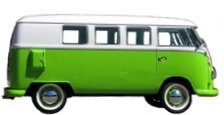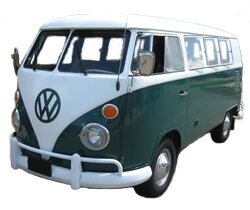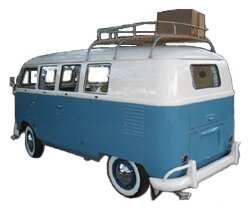Model Page
VW Type 2 T1 Splittie

|
Production Run: |
1,960,542 |
|---|---|
|
Production Date: |
1949 - 1967 (1975 in Brazil) |
|
Engine: |
Volkswagen Air Cooled Horizontally Opposed 4 |
|
Built: |
Wolfsburg (Germany) 1949 - 1956 Hanover (Germany)1956 - 1967 Sao Bernado do Campo (Brazil) 1950 - 1975 |
|
0-60: |
Approx 29 Secs |
|
Max Speed: |
Approx 55 Mph |

Officially launched on November 12, 1949, the VW Type 2 did not go on sale to the general public until March 1950 and continued in production until 1967. Known within VW circles as ‘Splitties’ due to the split screen window the vehicle was an instant hit and over 1.9 million were produced. The VW type 2 was launched at the Geneva Motorshow in 1949 and production began shortly afterwards on 8th March in 1950, initially only producing ten per day.

Volkswagen Type 2
The year was 1947 and the Volkswagen factory was being run by the British following World War 2. Ben Pon, a Dutch VW importer had seen motorised trolleys being used around the VW factory in Wolfsburg. These trolleys were made from stripped Beetles utilising their chassis and running gear and were used to transport car parts around the factory. (The transporter was the idea of Britain's Major Ivan Hirst who had been appointed to run the Wolfsburg factory after the war, having asked for a platform style carrier to be made for use within the factory) Pon developed a series of sketches that created a van based on the basic Beetle running gear and chassis.
The design, similar to a box on wheels interested Heinz Nordhoff, who had taken over as Chief Executive of Volkswagen in 1948 and so development of the product was taken on. The original design had very poor aerodynamics; improvements were made after many visits to a wind tunnel that was based at the Technical University of Braunschweig. Despite retaining the same slab sided design the revised design was aerodynamically superior to the original design. The Type 2 was the first van to position the driver above the front wheels and started a trend within Europe whereby vehicles such as the best selling Ford Transit adopted the layout.
The major styling feature of the Type 2 ‘Splittie’ was the split windscreen and sweeping v shaped line on the front of the vehicle, a large cast aluminium VW logo was positioned on the front and rear of the vehicle. The vehicle had a 170 cubic foot capacity in volume and was spacious enough to accommodate a 15 hand horse, payload capacity was around 750 Kg.
Unlike the Beetle upon which it shared the running components like the axle and engine, the Type 2 had a unitary construction that was supported by two longitudinal parallel beams upon which the vehicles components were mounted - the engine, suspension, gearbox etc, otherwise known as the ‘Ladder Frame’. This construction method reduced the torsional stiffness of the body construction and thus the handling of the machine suffered. However, a benefit of this construction method was that a larger payload could be borne by the vehicle.
With a rear engine layout, the first “Barn-door” panel vans had a disadvantage over its rivals with loading issues due to the engine cover intruding on interior space, models produced before 1955 are known as the “Barn-door” or T1A. Vehicles manufactured after 1955 had a revised body with the roofline above the windscreen being increased, the engine bay size being decreased and being fitted with 15” wheels – these are known as the T1b’s.This layout did provide benefits with increased traction with the additional weight over the driving wheels and reduced engine noise in the passenger cabin.
The bus used a horizontally opposed four cylinder, air cooled 1,131cc engine taken from the Beetle this unit generating 25 bhp @ 3,000 rpm. This was then replaced with a 1,192 cc engine in 1953, this unit produced 30 bhp @ 3,400 rpm. Furthermore this unit was then replaced with the 1,493cc high compression engine (raised to 7.0:1 from 6.6:1), becoming standard in 1955 this unit output 40 bhp @ 3,900 rpm and 65 lb/ft @ 2,400 rpm. It is interesting to note that in 1955 an usual early version of the 40bhp 1.5 engine was installed in the Type 2. The unit proved troublesome in the extreme and VW were forced to recall all 1959 Transports and replace the engine with an updated 40bhp engine. Since the engine was discontinued after such a short time, spares for these are not available and any remaining vehicles with the original engine are truly rare.

Volkswagen Type 2
Production started in the VW plant at Wolfsburg in 1950 and continued throughout until 1956 when production was switched to the Hannover facility at which production was kept until the model was discontinued in 1967. When released in 1950 the car went on sale at £435. The first Type II introduced was named the ‘Bulli’ that is best translated to Workhorse and was available as a Kombi, taken from the German ‘Kombinationskraftwagen’ meaning combination vehicle or Panel van models. The Panel vans did not include any windows along the side o the van and had no upholstery in the luggage compartment – it was designed for businesses as a low cost delivery van. The Kombi was fitted with three windows running down each side and designed to carry people and or cargo. Optionally two sets of rear bench seats were installed and these could be removed to increase load capacity. The Microbus was top of the range and received upholstered seats with matching interior panels and a cloth or vinyl headlining as standard. This vehicle came equipped with chrome hubcaps and two tone paint. A Deluxe version of the Microbus could be ordered, with this model the number of lights could be increased to four windows down each side (five if a curved Plexiglass window was installed in the corner) and up to four skylights installed.
Within the first five years of production over 90 variations of body had been produced ranging from pick up trucks, buses, ambulances, fire engines, ice cream vans, milk floats, delivery vans and campers.
In 1951 the Westfalia Camper was introduced, Westfalia was a coach building company in Germany, they produced the camper van kitting the vehicle out with furnishings and cooking equipment. (For further information please refer to the Westfalia information page).
There are three distinct variations of the Type II, the T1A was available from launch until 1955, this being replaced with the T1B that was manufactured between 1955 and 1963, the T1C was the final variant, produced between 1963 and 1967. The T1C models were equipped with a larger rear door and optionally a sliding door was offered for the passenger area instead of the previous versions outwardly swinging doors.
In 1962 a heavy duty transporter was introduced as a factory option, this vehicle had an increased load capacity of 1,000 Kg – up from the standard 750 Kg. This model was fitted with 14” wheels with these being of a wider variety. The engine was upgraded to a 1.5 42 bhp unit, the model proved highly successful and due to this the 1.2 litre transporter was discontinued.
The Facts
|
Engine: |
VW Air Cooled Horizontally Opposed 4 Cylinder |
|---|---|
|
Capacity: |
1,131cc 1,192cc 1,493cc |
|
Valves: |
8 |
|
Compression Ratio: |
1,131cc - 5.8:1 1,192cc - 6.6:1 / 7.0:1 1,493cc - 7.8:1 |
|
Fuel System: |
Single SO Carburettor |
|
Maximum Power: |
1,131cc - 25 bhp @ 3,000 rpm 1,192cc - 30 bhp @ 3,400 rpm 1,493cc - 50 bhp |
|
Maximum Torque: |
1,131cc - n/a 1,192cc - n/a 1,493cc - 65 lb/ft @ 2,400 rpm |
|
Transmission: |
Manual 4 speed. |
|
Top Gear: |
- |
|
Brakes: |
Front Drums / Rear Drums |
|
Kerb Weight: |
1105 Kg (Deluxe 1.5) |
|
Max Speed: |
Approx 55 Mph |
|
0-60: |
Approx 29 Secs |





